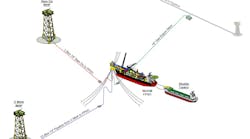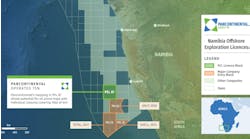Gurdip Singh
Contributing Editor
Asia’s place in the world of offshore oil and gas exploration and production is growing in importance as industry activity in the region continues to gain momentum. Total regional capex will exceed $90 billion during the period 2011-2015, predicts Infield Systems Ltd.
In this atmosphere of growth and urgency, almost 4,000 oil and gas industry professionals met recently at the 7th annual Offshore Asia Conference & Exhibition in Kuala Lumpur, Malaysia. The region’s premier offshore exploration and production conference and exhibition featured more than 50 international companies showcasing the latest technologies, products and services, and more than 30 speakers presenting case studies and new technology presentations.
Chen Kah Seong, senior general manager of the petroleum engineering division at Petronas Development and Production, delivered the keynote address at the plenary session of Offshore Asia 2012. In the address, “Taking the Steps Forward,” Chen said that in order to meet the demand, Petronas plans to maintain, maximize, and grow its domestic assets.
Malaysia requires the highest percentage share of the estimated capex among all major offshore producing nations in the region if it is to meet its target to increase aggregate production capacity by 5% per year through 2020.
The Malaysian national oil company, Petronas, is challenging international service providers to meet the technology needs for deepwater exploration and high-pressure/high-temperature (HP/HT) wells in marginal fields and to manage matured reservoirs across the Asia/Pacific region.
Chen gave the audience several examples of the kinds of projects and approaches Petronas says will be needed to meet the production increase.
Petronas and Shell Malaysia have signed two new production sharing contracts for enhanced oil recovery projects offshore Sarawak and Sabah. Under the new contracts, Shell Malaysia’s upstream companies and partner Petronas Carigali Sdn. Bhd. will further develop six oil fields in the Baram Delta offshore Sarawak, and three oil fields in the North Sabah development area offshore Sabah, using EOR or “other appropriate related technologies.”
The deal combines the remaining periods of the earlier PSCs which would have expired in 2018 (Baram Delta Operations) and 2019 (North Sabah) with license extension to 2040, and with the addition of the EOR component for integrated PSCs with new terms.
“There are a lot of stranded assets in the region. More of these are far away from existing production facilities,” said Chen. “The challenge is to monetize these assets as the bigger assets are getting lesser and lesser.”
Petronas is looking for fasttrack oil production using innovative and creative management. “One of the key factors of success in such case would be for the oil company to work very closely with the industry,” said Chen, to adopt innovations that may not be proven technology.
Will Rowley, group analyst at Acteon Group Ltd., is positive about prospects in the matured Malaysian upstream sector, he told the plenary session. “Malaysia is viewed as a market that is ripe for accelerated growth and development with a significant number of deepwater and shallow-water opportunities.”
Rowley echoed Chen in saying the Malaysian upstream sector should improve the application of existing and proven technology. “In this aspect, the key innovation and creative thinking is not to push the technological envelope but to be able to select the best proven techniques, processes and equipment, and apply them successfully in a way that allows the Malaysia supply chain to deliver increased efficiency and effectiveness,” he said.
Bullish sentiment
Malaysia is a vital part of the global upstream sector. The country is set to invest $500 billion a year and has a cash reserve of $200 billion. Energy-short Asia is an attractive place to generate margins for service companies because of the massive demand for technology and expertise. However, upstream developments face a manpower problem.
The merger of the Kencana and Sapura groups was a main talking point in the effort to build local capability and capacity. Petronas’ forthcoming project demand a world-scale engineering, procurement, construction, installation and commissioning expertise, which could come from the merged entity.
Upon completion, the merger between Kencana and SapuraCrest Petroleum Berhad will see special-purpose investment vehicle Integral Key Berhad acquire all the assets and liabilities of Kencana for RM5.98 billion ($1.88 billion) and SapuraCrest for RM5.87 billion ($1.84 billion).
In other business discussed at the conference and exhibition, Aker Solutions is implementing a $200-million expansion at its plant at Port Klang on the west coast of peninsular Malaysia. Dave Hutchinson, president, subsea Asia/Pacific, said the final $50-million investment would be completed in the 2012-13 fiscal year. The technology-driven company has started increasing manpower by 10% a year, adding to its 1,500-employee workforce.
“The Malaysian markets are very promising, and we will continue our investment plan in the country [by] turning the Port Kelang plant into an Asia/Pacific center,” said Hutchinson. Aker Solutions has a contract with Murphy Sabah Oil Co. Ltd. to deliver a subsea production system for the Kikeh subsea expansion project off the coast of Sabah in East Malaysia. Aker will deliver deepwater oil production equipment such as subsea trees, control modules, distribution systems, and manifolds to be installed in water depth of 1,350 m (4,430 ft). The project will be delivered out of the manufacturing center in Port Klang, Malaysia, and the subsea hardware is expected to be on production in 2013.
Specialist product suppliers have worked out strategic plans for the Malaysian market, and plan to make the country a launching pad for the rest of the region in the coming years. They have also noted the Malaysian government’s often repeated calls to make Malaysia a deepwater technology hub.
“We are looking first at Malaysia as our growing market, especially focusing on offshore Sabah and Sarawak,” said Jan J. Tollet, managing director for Asia at CRC-Evans Pipeline International Pte. Ltd. Tollet rates Malaysia among the top markets since Asian pipeline projects account for 40% of the 100,000 km (62,140 mi) of pipelines to be built globally in the next five years.
CRC-Evans Pipeline expansion in the future likely will include new centers in Australia, Indonesia, and Vietnam in three to five years, having started in Malaysia with an automatic welding equipment business.
TMK Group targets direct participation in Petronas projects. “We need to increase our supply through the Petronas tender-based contracting system,” said Igor Tolkachev, head of the technical sales division. The Moscow-based company exports 40% of its total production to the US and Middle East markets but is on the lookout for a strategic partnership in Malaysia.
China Petroleum Technology & Development Corp. (CPTDC) wants a bigger share of the Malaysian oil and gas market. “We are looking at opportunities to supply drilling and production equipment, tubing and casing as well as platforms,” said Chen Jiye, deputy general manager at the Oilfield Development Equipment Department.
The Singapore-based Reliant Oilfield Products Pte. Ltd. (ROP) has started forming partnerships with drilling contractors to supply welding wires. “We are in the early stage of building business links with Malaysia but it is a leading market for us,” said David Moore, director of ROP.
Dana Engineering Sdn. Bhd. senior director Kazi Hassan Sharif banks on doubling the supply to Malaysia of Waukesha gas engines made in the US and Austria. Petronas plans to develop marginal fields with high CO2 content, which could boost the use of generators in the coming years, added Dana’s director for operation Mohd Khuzaimie Bin Shahari.
Oil States said it has a range of services to offer Asian markets and plans to start with Malaysian deepwater projects. Among its new offerings is the heave compensation flexible system on installation vessels. The system offsets the impact of high wave waters during the installations of subsea systems, said deck equipment sales manager Alan Corley.
Offshore Asia returns to Kuala Lumpur in March, 2013, to again examine the status of upstream exploration and production operations and technology in and for the Asia/Pacific region. For more information look online athttp://www.offshoreasiaevent.com/index.html.


